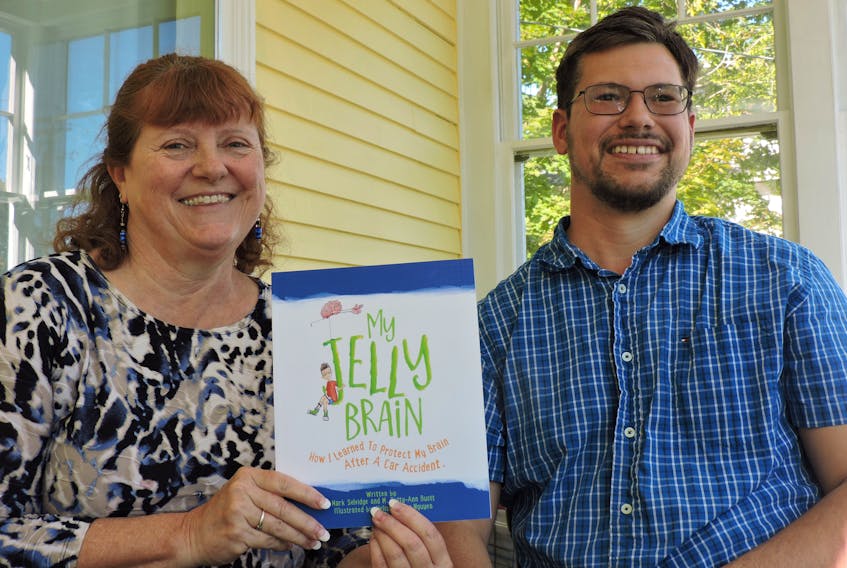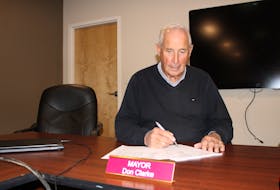WOLFVILLE, N.S. — When Mark Selvidge talks to public school students about the dangers of brain injuries, he usually brings along a couple of watermelons.
The two melons are the stars of his experiment, one with a helmet strapped on and one without, which he drops from waist level to give his young audiences an idea of what could happen to their heads in the blink of an eye.
“When you cut the melons open, you can see the one with no helmet got damaged greater,” says Selvidge on the sun porch of his Wolfville home.
“But then we slice up the melons and all the kids get a snack.”
When he talks about brain injury, and the need for helmets and other safety precautions when enjoying risky activities, Selvidge is speaking from his own experience, which he details for young readers in the new illustrated book My Jelly Brain, co-written with his counsellor and life coach M. Betty-Ann Buott.
“The ‘jelly brain’ title came from the fact that your brain is the same consistency as a bowl of Jell-O,” says Selvidge.
“And if I can prevent one kid from going through a quarter of what I went through, I’d feel like I’d won a million dollars.”
For nearly two decades, every day has been another step in the recovery process since he was in a serious car accident outside Red Deer, Alta., which also took the life of his younger sister Nicole.
Learning life from scratch at age 11
Selvidge spent his 11th birthday in a coma, followed by three months in the Calgary Children’s Hospital intensive care unit, followed by months, then years of work to get him where he is today.
“I went through intensive rehab. Speech, language, physio, OT, plus schooling, all at the Calgary Children’s Hospital,” he recalls.
“I had to learn everything all over again, like an infant, from the age of 11.”
Seated nearby on the sunporch, his mother Sherry remembers a landmark moment in hospital: seeing her son smile with a corner of his mouth in the hospital after a family member cracked a joke.
“I just thought, ‘Oh, Mark is there. He heard us, he understood us!’ ”

Understanding is a major part of Selvidge’s message too, ever since Buott first suggested that they go into schools with their message of helmet and head safety and empathy for others, which made putting his story on the page a natural next step.
“The idea of the book is to help children to understand that they only have one brain,” says Buott, who says Selvidge’s injury has taken an emotional toll as well as a physical one due to bullying he suffered in school.
The message that they need to protect themselves goes hand-in-hand with the need to consider the feelings of others with disadvantages.
“For us, the book will also help children understand that somebody out there knows how they feel when maybe they’re not included or maybe they’re not accepted,” she says.
“That’s a big part of the book as well, the whole idea of inclusion and that just because somebody’s different doesn’t mean that they don’t have a worthwhile contribution to make.”
Taking the message of safety and empathy further
My Jelly Brain is currently in schools throughout the Annapolis Valley and available from local bookstores The Market in Wolfville and RD Chisholm's in Kentville as well as online retailers like Amazon and others, and Selvidge plans to take it further throughout the province and beyond. Its message is brought to life through big, bold, colourful illustrations by Melissa Baker Nguyen of its author and an anthropomorphic brain that helps underline the science and point out the health implications of a head injury in a way that’s approachable and sometimes funny.
“She did an amazing, A-1 job on the illustrations,” says Selvidge, who worked closely with Nguyen to make sure the boyish book version of himself didn’t shy away from presenting the physical disability of his partially immobile right arm and right leg brace.
He also wanted to make sure the book was bright, eye-catching and funny to keep its readers engaged. Like presenting the two melons from Selvidge’s and Buott’s school talks with a happy, helmeted face and a sad, bruised noggin.
“You need humour to get a message across in today’s society, especially with a traumatic brain injury such as mine,” he says. “You need humour, because to this day I still implement it on a daily basis.
“So I just don’t take offence at the stuff that happens every day.”
Book launch one of many life milestones
The publication of My Jelly Brain is one of several milestones Selvidge has accomplished over the past decade. They include buying a home in Wolfville, travelling solo to New Zealand and Australia where he snorkeled and flew shotgun in a biplane, soaking up the vibes from the energy vortexes in Sedona, Ariz., and acing a motorcycle and small engine repair course at NSCC Kingstec campus.
Currently, he’s studying community development at Acadia University, and hopes to start an organization that takes students with functional disabilities out for experiences that most people never get to enjoy in the course of their daily lives.
“Things like rock climbing, which I’ve done and it feels like a million dollars once you reach the top, even with a bad arm,” he says.
“Or hot air ballooning, which isn’t dangerous, but how many people have had a chance to do it? Ziplining, horseback riding, things the kids can do that makes them feel like a million dollars.”









